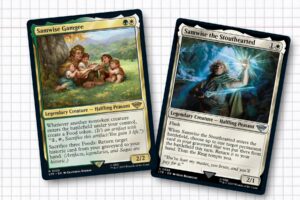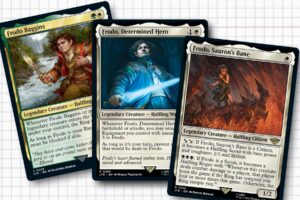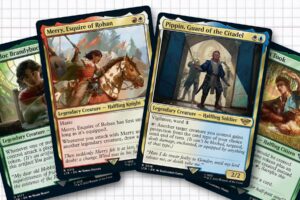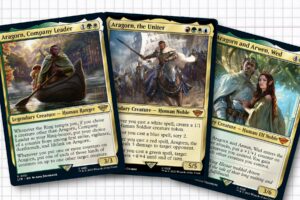I started playing Magic: the Gathering the summer between the release of Lord of the Rings: The Fellowship of the Ring and Lord of the Rings: The Two Towers. At that time, I was swept up in the cultural hysteria, just like the rest of the world. Discovering Magic allowed me access to a highly illustrated game that looked a lot like the movie that had delighted me. The only issue, for as high fantasy as the game may have been, I would not be able to assemble my fellowship without allowing for some flavor bends.
I wouldn’t discover Amrou Kithkin until at least the Time Spiral block, so copies of Eager Cadet stood in for the hobbits, Quirion Elves and Skyshroud Archer acted as the elves, and Barrin, Master Wizard, was my Gandalf. Then there was Sisay’s Ring standing in for The One Ring, because copies appeared in the artifact boxes at my local comic book store, and even a diligent search through Gatherer didn’t alert me of Sol Ring, at that time.
A casual Lord of the Rings theme deck would not sustain my interest for too long. But the forthcoming Onslaught block would capture my attention with narrative storytelling which intrigued me within the context of a card game. For a long time, Odyssey was one of my most poured-over sets of all time. Because of this, I had a vested interest in Kamahl, Pit Fighter and his supporting cast. To see his reincarnation as Kamahl, Fist of Krosa and his sister, Jeska, Warrior Adept, die and be reborn as Phage the Untouchable was nothing short of riveting. Watching these siblings go from the same color identity to enemy colors was a subtle way of showing how their stories grew in opposite directions. Kamahl embraced the natural world and Phage fell away from it.
While these arcs took place over the course of the Odyssey and Onslaught blocks, the nature of The Lord of the Rings: Tales of Middle-earth allowed the designers to encompass the arcs of many characters all in one set. References exist all across the set, with so many characters seeing print as legendary creatures. As a writer who focuses on Commander, it was honestly a little overwhelming; to the point where I didn’t want to force the issue and try to deliver a half-baked Gríma Wormtongue or Fangorn, Tree Shepherd deck, just because my intention was to put focus on The Lord of the Rings: Tales of Middle-earth. Today, I’d like to take a step back and look at some of the characters that got multiple iterations across this set and Tales of Middle-earth Commander. See how each entry shows off different aspects of these characters and how things like mechanics and color identity do so much heavy lifting.
Frodo and Samwise
The story told across Frodo Baggins, Frodo, Determined Hero, and Frodo, Sauron’s Bane really spoke to me. I admire the choice to start Frodo in the color identity we would commonly associate with the community, strip that away to entirely white and, eventually lead to the point when his color identity has shifted to Orzhov. In other contexts, I might be critical of Magic for making such an objective use of the color pie to represent the morality of a character. But I think in the prototypical fantasy story, we can employ these more heavy-handed themes.
The story the three cards tell in sequence is also clever. As you build your fellowship with Frodo Baggins, the ring is constantly tempting you. In this first state, Frodo is also actively being pursued and will be blocked at every opportunity. As we move to Frodo, Determined Hero, we see a Frodo how better equipped to take on the world, he has his protections now and access to Sting, the Glinting Dagger. And finally, we see Frodo as an abridged Figure of Destiny. What I really love here is the gradual requirement of Black mana, starting out as unessential and soon becoming mandatory. Even the power and toughness helps to paint a picture of how Frodo, first starting out more defensive, becoming more well-rounded, before ultimately becoming rather frail, only growing in stats as he dips further into darkness.
 While I may have less to say about Samwise Gamgee, I can appreciate how he comes from the same roots as Frodo. My core knowledge of the character, mainly sustained by the pop culture of the last two decades, does tie him to food in a pretty large way, but also to history and storytelling. I believe this is very well captured in his Selesnya version. Thematically, I also like that Samwise takes the same path away from the communal aspects and becomes mono white. And it is also in this Samwise the Stouthearted state that the method of ring temptation goes from Frodo to Sam, allowing them to remain synergistically linked.
While I may have less to say about Samwise Gamgee, I can appreciate how he comes from the same roots as Frodo. My core knowledge of the character, mainly sustained by the pop culture of the last two decades, does tie him to food in a pretty large way, but also to history and storytelling. I believe this is very well captured in his Selesnya version. Thematically, I also like that Samwise takes the same path away from the communal aspects and becomes mono white. And it is also in this Samwise the Stouthearted state that the method of ring temptation goes from Frodo to Sam, allowing them to remain synergistically linked.
Merry and Pippin
I find the designs of Merry, Esquire of Rohan and Pippin, Guard of the Citadel to be fascinating looks at the two characters. We find these two represented during the latter half of the overall story. But what really comes across is the fact that they have lost the green identity connected to The Shire – kinda like Frodo and Samwise. But moreover, I really appreciate how the two characters are contrasted. I love Merry being this hasted knight, pushing you to charge into battle alongside others and Pippin being the legendary Mother of Ruins we didn’t know we needed. This helps to capture how Merry is the more adventure seeking of the two and Pippin the more passive and kind.
It’s weird, to think how far they have both come from their mono green roots, as Meriadoc Brandybuck and Peregrin Took. These cards, focused so much on food – as any good hobbit, I suppose – feel like such a departure, that the retitling of the characters seems very appropriate. From this point, I will readily admit I don’t know that I entirely agree with the color identity they take on in the Commander set. While I understand that Merry, Warden of Isengard and Pippin, Warden of Isengard needed to fit into the same color identities as to match Sam, Loyal Attendant and Frodo, Adventurous Hobbit, I don’t follow the narrative arc these cards are trying to convey.
Aragorn
The last character I’ll touch on today may get the most iterations across the two Lord of the Rings sets, that being Aragorn, the would-be King of Gondor. Starting out, relatively undercover, Strider, Ranger of the North is how we initially find Aragorn at the beginning of the story. Like any good ranger, Strider benefits from their expertise within the wilderness, as represented by landfall. In the next incarnation, as Aragorn, Company Leader, he has now joined the fellowship and thus takes on rules text that connects him to the ringbearer mechanic. Additionally, his color identity now aligns with Frodo Baggins and Samwise Gamgee, and we get to see Aragorn as the natural leader he is, through the counter sharing displayed across both of his abilities.
Moving forward, we next get Aragorn, the Uniter, as he battles at Minas Tirith. Taking on the full spectrum of color identity, minus the heavy-handed black, Aragon shows off his connection to each color with as much finesse as The Avatar. But I love that his story doesn’t end there, we get to see Aragorn not only as Aragorn, King of Gondor in Tales of Middle-earth Commander, but as married man on Aragorn and Arwen, Wed. These regal designs help to show how far Aragorn came over the course of the story. But, think my favorite of the two is Aragorn and Arwen, Wed, because it shows the kingdom they can build together.
The character development on display in this set has made me nostalgic for my early roots with Magic: the Gathering. While there certainly is plenty of character development on display within our lore, take Liliana or Ajani as examples, these arcs tend to play out over the course of many years. When you’re used to decades spanning story arcs, these condensed arcs can feel rather satisfying. As such, I do miss the expression of character arcs through legendary creatures on a more consistent basis and maybe that’s where we’re headed, now that March of the Machine Aftermath has defined some of the ramifications of Magic’s latest chapter.
Ryan Sainio (he/him) is a Graphic Designer exploring the Commander format and Magic history on a regular basis. Notable decks that value flavorful and fun gameplay over competitively optimized decks include Shattergang Eldrazi, Doran Soul Sisters, and Chatterfang ProsBloom.
MTG Content Creator Awards 2022 nominee: Format Specialty Writing & Excellence in Writing Overall




